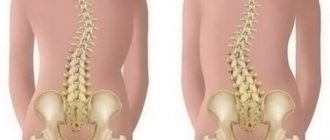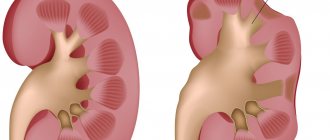Ebola fever - causes, symptoms, diagnosis, treatment (V.I. Pokrovsky, 2007)
an acute, presumably zoonotic disease from the group of viral hemorrhagic fevers, occurring with severe hemorrhagic syndrome, characterized by a high mortality rate.
Refers to particularly dangerous viral infections.
Etiology The causative agent of Ebola fever is an RNA genomic virus of the Filovirus genus of the Filoviridae family. Three strains of the virus have been identified - Zaire, Sudan, Renston - differing in antigenic structure. Clear differences were identified between the Zaire and Sudan strains in genetic, biological and biochemical properties. In laboratory conditions, cultures of the pathogen are maintained by passage through the liver or blood of monkeys. The Ebola virus has a moderate degree of resistance in the external environment.
Ebola virus
Epidemiology The reservoir and source of infection in nature has been little studied; most likely, it is mainly represented by a variety of rodents. The role of monkeys as sources of infection cannot be ruled out. A sick person is very dangerous to others; 5-8 consecutive transmissions of the virus from a patient and the occurrence of nosocomial outbreaks of the disease are known. It was noted that during the first transmissions the mortality rate was the highest (100%), then it decreased. The virus is detected in various organs, tissues and secretions: in the blood (7-10 days), nasopharyngeal mucus, urine, sperm. The patient poses a high risk within 3 weeks from the onset of the disease; During the incubation period, the patient does not secrete the virus.
The mechanism of transmission
of Ebola fever is varied. The polytropic nature of the virus and the variety of ways it is released from the body determine the possibility of infection through contact with the blood of patients, through sexual and aerosol routes, through the use of common household items and sharing food. It has been established that infection with Ebola fever is mainly realized through direct contact with infected material. The disease is very contagious and is transmitted when the virus comes into contact with the skin and mucous membranes .
Blood is the most dangerous. The greatest risk of infection is faced by medical personnel when caring for the sick, as well as personnel involved in catching, transporting and caring for monkeys. The natural susceptibility
of people to Ebola is high.
Post-infectious immunity is persistent.
Repeated cases of disease are rare;
their frequency does not exceed 5%. Main epidemiological signs:
foci of Ebola virus circulation are located in the tropical rainforests of Central and Western Africa (Zaire, Sudan, Nigeria, Liberia, Gabon, Senegal, Kenya, Cameroon, Ethiopia, Central African Republic).
Outbreaks of Ebola fever in endemic areas occur mainly in spring and summer.
Pathogenesis During
the incubation period, the Ebola virus reproduces in regional lymph nodes, the spleen and possibly other organs. The acute onset of the disease with fever coincides with the development of intense viremia with multiorgan dissemination of the pathogen. Damage to cells and tissues of various organs is presumably due to both the direct cytopathic effect of the virus and autoimmune reactions. The development of disturbances in microcirculation and rheological properties of blood is manifested by capillary toxicosis with hemorrhagic syndrome, perivascular edema, and disseminated intravascular coagulation syndrome.
Disseminated intravascular coagulation is the leading syndrome detected histologically.
Pathological changes in organs in the form of focal necrosis, scattered hemorrhages in the clinical picture are manifested by signs of hepatitis, interstitial pneumonia, pancreatitis, orchitis, etc. The reactions of cellular and humoral immunity are reduced, antiviral antibodies are rarely detected in those who died in the early stages of the disease, in those who recover they appear late .
Clinical picture The incubation period varies from several days to 2-3 weeks.
The onset of the disease is acute, with an increase in body temperature to 38-39 ° C, headache, myalgia and arthralgia, malaise, and nausea. During the first days, most patients experience symptoms of sore throat; Inflammation of the tonsils causes a painful “ball in the throat” sensation. At the height of the disease, uncontrollable vomiting, abdominal pain and hemorrhagic diarrhea with stool in the form of melena occur.
Hemorrhagic syndrome develops rapidly with manifestations of skin hemorrhages, organ bleeding, and hematemesis. Signs of encephalopathy are often observed in the form of agitation and aggressiveness of patients; in cases of recovery, they persist for a long time even during the period of convalescence. On the 4-6th day from the onset of the disease, in approximately half of the patients, an exanthema of a confluent nature appears.
Death with Ebola fever usually occurs at the beginning of the 2nd week of illness.
Its main causes are bleeding, intoxication, hypovolemic and infectious-toxic shocks. In cases of recovery, the acute phase of the disease lasts 2-3 weeks. The period of convalescence lasts up to 2-3 months and is accompanied by asthenia, anorexia, weight loss, hair loss, and sometimes the development of mental disorders. Differential diagnosis
It presents significant difficulties due to the lack of specific clinical signs and the rapidity of development of the disease. Ebola fever can be brought to our country from the countries of Central and Western Africa.
Laboratory diagnostics
Provides for the use of PCR, ELISA, immunofluorescent methods, and the performance of serological tests (RN, RSK, RNGA). The methods are available only in well-equipped virology laboratories under strict anti-epidemic regime. In the field, you can use a comprehensive diagnostic kit for RIF or enzyme-linked immunosorbent test systems to detect antigens of the Ebola and Marburg viruses, as well as antibodies to them.
Diagnostic methods
For our country, Ebola fever remains an extremely rare disease, so diagnostic tests are performed in specialized virology laboratories that adhere to the highest biosafety standards. The virus is isolated from any biological fluids of the patient, after which it is transferred to cell cultures, PCR tests are performed, and biopsies of the skin and internal organs are examined using an electron microscope. In addition, a general analysis and blood coagulogram are performed to identify characteristic changes.
Prevention
Due to the high contagiousness, the transmission routes of the disease are too different. The main rule is not to get sick. This is especially true for doctors working with infected people or directly with the virus. Several rules can be derived to reduce the risk of spreading the disease.
- Do not contact sick people, as the virus is transmitted by airborne droplets, tactile contact, etc.
- If you get sick, you should call an ambulance and immediately indicate that your illness is suspected of Ebola. This will allow doctors to wear special protective suits and not become infected.
- When in contact with sick people, it is important to use gloves, a face mask and avoid any contact.
- All hygiene items of the sick person must be disposed of to prevent the spread of infection.
- Even when working with people who have died from Ebola, care must be taken because the virus continues to live even in a dead body.
Knowing how the disease spreads can help you take safety measures.
Diet
Dietary nutrition is prescribed that corresponds to Table No. 4 according to Pevzner, which provides a diet containing the physiological norm of protein with a limitation of fats and carbohydrates. All products that enhance the processes of rotting/fermentation in the intestines and the secretion of the digestive organs are excluded: liquid, semi-liquid and mashed dishes, steamed/boiled in water are indicated. The power mode is fractional. During the recovery period, a diet with a high content of animal protein is indicated.
Features of the treatment process
For Ebola treatment, the patient is transported in a special isolation box to an equipped medical facility and placed in a closed box with appropriate measures in place to prevent further spread of the infection. Medical personnel use comprehensive barrier protection and monitor the patient’s condition around the clock. Therapy consists mainly of eliminating the effect of toxins on the patient’s body, combating dehydration that occurs due to prolonged diarrhea, and manifestations of hemorrhage. The administration of blood plasma taken from recovered people in some cases has a positive effect on the course of the disease.
To date, a vaccine against hemorrhagic fever has not yet been developed, although tests of experimental samples are being carried out in laboratories in several countries. Ebola prevention involves tracing the contacts of sick people and promptly isolating all people who have been in contact with them, even for a short time.
Equal importance is attached to sanitary measures - quarantine control at airports, compliance with personal protection rules, disinfection of premises and household items used by infected people. People suspected of being infected with the Ebola virus are prescribed a specific immunoglobulin, which is produced from blood serum. The high mortality and contagiousness of the infection make it necessary to take the most severe measures to prevent the possibility of its spread.
Signs and symptoms
Ebola fever is a severe, acute viral infection that begins suddenly with fever, severe weakness, muscle pain, headache, sore throat (i.e., like the common flu). Then vomiting, diarrhea, rash, impaired renal and liver function, and bleeding (internal and external) appear. In the blood, laboratory tests indicate a decrease in the level of leukocytes and platelets and an increase in the number of liver enzymes. To make a diagnosis, a number of other infectious diseases are first excluded, and the final diagnosis is made only in the laboratory based on a series of tests.
Epidemiological surveillance
The implementation of the International Epidemiological Surveillance System for Contagious Hemorrhagic Fever is intended to provide the necessary information for the timely and complete implementation of preventive measures. Due to the difficulty in some cases of carrying out full laboratory diagnosis of diseases, clinical manifestations become of utmost importance. Taking into account the WHO concept, all countries are required to immediately notify headquarters of single or group severe diseases characterized by acute hemorrhagic fever syndrome. According to the definition of the WHO Expert Committee, a patient with Lassa, Marburg and Ebola fever is a person with a febrile illness accompanied by one or more of the following signs: virus isolation, a 4-fold increase in antibody titers to the virus 1-2 weeks after collection. With Lassa fever, IgG titers upon admission are at least 1:512 and positive IgM titers; for Marburg and Ebola fevers, the IgM content is 1:8 and higher, IgG - 1:64 in the RIF.
What happens in the human body after the Ebola virus enters it?
During the incubation period (from 2 to 21 days), when a person is not contagious, the virus multiplies in the lymph nodes, spleen, and possibly in other organs. This is followed by an acute onset with fever. Damage to the body's cells and tissues is associated both with the direct influence of the virus itself and with the autoimmune reactions it triggers, when the body's antibodies attack its own cells, recognizing them as foreign. Microcirculation is disrupted, which is clinically manifested by bleeding, swelling and disseminated intravascular coagulation (blood clotting in blood vessels). Necrosis and hemorrhage appear in organs. An infected person develops symptoms of hepatitis, pneumonia, pancreatitis, orchitis, etc. Antibodies necessary to fight the virus are produced by the body late (this was revealed during the examination of people who were ill but survived).
Etiology
The causative agent of Ebola fever is an RNA virus. According to the structure, pathogenicity and area of distribution, 5 subtypes of the virus are identified: 1. Ebola-Zaire (Ebola-Zaire, EBO‑Z, EBOV); 2. Ebola-Sudan (Ebola-Sudan, EBO‑S, SUDV); 3. Ebola-Tai Forest, formerly called Ebola-Côte d'Ivoire (Ebola-Tai Forest, TAFV; Ebola-Cote d'Ivoire, Ebola-Ivory Coast, EBO-CI); 4. Ebola-Reston (EBO‑R, RESTV); 5. Ebola-Bundibugyo (BDBV). Ebola-Reston is not believed to cause disease in humans. Ebola-Zaire is considered the most virulent, Ebola-Sudan and Ebola-Bundibugyo are less virulent, and Ebola-Tai Forest is the least virulent.
Ebola virus infection in Russia
In 1996, a laboratory assistant at the Virology Center of the Research Institute of Microbiology of the Ministry of Defense of the Russian Federation in Sergiev Posad died, having become infected with the Ebola virus through negligence (she pricked her finger while injecting rabbits). On May 19, 2004, a senior laboratory assistant at the Department of Particularly Dangerous Viral Infections of the Research Institute of Molecular Biology of the State Scientific Center for Virology and Biotechnology “Vector” (Novosibirsk Region) died from Ebola fever. The infection also occurred due to negligence: while giving injections to experimental guinea pigs, the woman punctured her skin.









